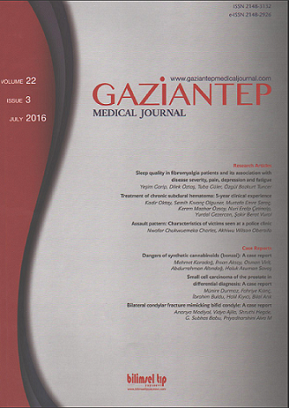Assault pattern: Characteristics of victims seen at a police clinic
Saldırı modeli: Polis kliniğinde görülen mağdurların özellikleri
DOI:
https://doi.org/10.5152/EurJTher.2016.003Abstract
Introduction: Interpersonal assaults (IA) are commonly seen in our environment. The aim of this study was to document the injury patterns following IA.
Materials and Methods: This is a review of all the IA cases seen and examined at the police clinic, Benin City, Edo State, Nigeria.
Results: A total of 426 people were assaulted during the period, comprising 246 males and 180 females in a male to female ratio of 1.4:1. Age groups 30-39 years and 20-29 years accounted for 70.4% of cases. About 41.3% of victims had secondary level of education while 71.1% of the victims were self employed. Eighty two point four percent of the assaults occurred during the day time. In 33.5% and 10.3% of the assaults, the assailant was either one male or one female respectively. Bruises/haematomas/abrasions were the commonest injuries seen (59.4%), while incised/stab wounds and lacerations accounted for 17.6% and 15.7% respectively. The most severe injury seen was a case of quadriplegia (0.2%). The commonly used instruments of assault were; fist (22.9%), wood (22.6%), human bite (16%), cutlass/machete (12.6%) and broken bottle (11.2%). The head/face/neck region accounted for 57.1% of cases, while upper limb and lower limb each accounted for 27.6% and 17.7% of injury sites respectively.
Conclusion: Body parts were more commonly used in IA and the injuries were usually mild and not life threatening.
Metrics
References
Rao D, Sudhakar, Rashmi. A study of pattern of non fatal injuries due to assault. J Punjab Acad Forensic Med Toxicol 2014;14(2):82-5.
Bhullar DS, Aggarwal KK. Mediological diagnosis and pattern of injury with sharp weapons. J Indian Acad Forensic Med 2007;29(4):110-4.
Nkombua L. Pattern of injuries suffered by patients treated for alleged assault at Witbank General Hospital, Mpumalanga. South African Family; Practice 2007;49:10:14-14D.
Wright J, Kariya A. Assault patients attending a Scottish accident emergency department. J R Soc Med 1997;90:322-6.
Downing A, Cotterill S, Wilson R. The epidemiology of assault across the West Midlands. Emerg Med J 2003;20:434-7.
Thube H R, Chikhalkar B G, Nanandkar S D. A Prospective study of injury pattern in victim of assault attended in south mumbai Government Hospital. J Indian Acad Forensic Med 2015;37(1):37-40.
Brennan I R, Moore S C, Shepherd J P. Non-firearm weapon use and injury severity: priorities for Prevention. Injury Prevention 2006;12:395-9.
Stein D J, Boshoff D, Abrahams H, Daniels F, Traut A, Traut A, et al. Patients presenting with fresh trauma after interpersonal violence. Part II. Assault history. S Afr Med J 1997;87:999-1000.
Brink O, Vesterby A, Jensen J. Pattern of injuries due to interpersonal violence. Injury 1998;29:705-9.
Shepherd JP, Shapland M, Pearce NX, Scully C. Pattern, severity and aetiology of injuries in victims of assault. J R Soc Med 1990;83:75-8.
Sumner BB, Mintz ER, Brown PL. Injuries caused by personal violence. Injury 1987;18:258-60.
van Geldermalsen AA, Van der Stuyft P. Interpersonal violence: patterns in a Basotho community. J Trop Med Hyg 1993;96(2):93-9.
Shepherd J, Scully C, Shapland M, Irish M, Leslie IJ. Assault: characteristics of victims attending an inner-city hospital. Injury 1988;19(3):185-90.
Keith AM. Taylor’s principles and practice of medical jurisprudence. 13th ed. United Kingdom: Churchill livingstone, 1984;214-48.
Felson RB, Messner SF. To kill or not to kill? Lethal outcomes in injurious attacks. Criminology 1996;34:519-45.
Jaffe Y, Yinon Y. Retaliatory aggression in individuals and groups. Eur J Soc Psychol 1979;9:177-86.
Dalal JS. Clue of weapon from description of apparel. JPAFMAT 2005;5:47.
Glucksman E. Alcohol and alcohol problems. Alcohol and crime. Br Med Bull 1994;50:76-84.
Downloads
Published
How to Cite
Issue
Section
License
Copyright (c) 2023 European Journal of Therapeutics

This work is licensed under a Creative Commons Attribution-NonCommercial 4.0 International License.
The content of this journal is licensed under a Creative Commons Attribution-NonCommercial 4.0 International License.


















